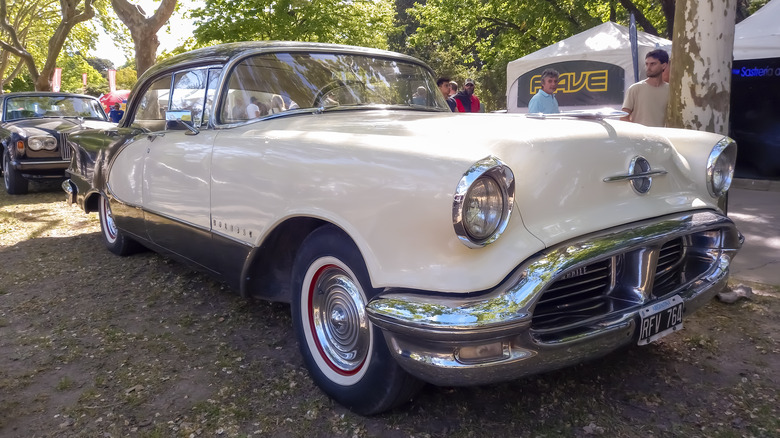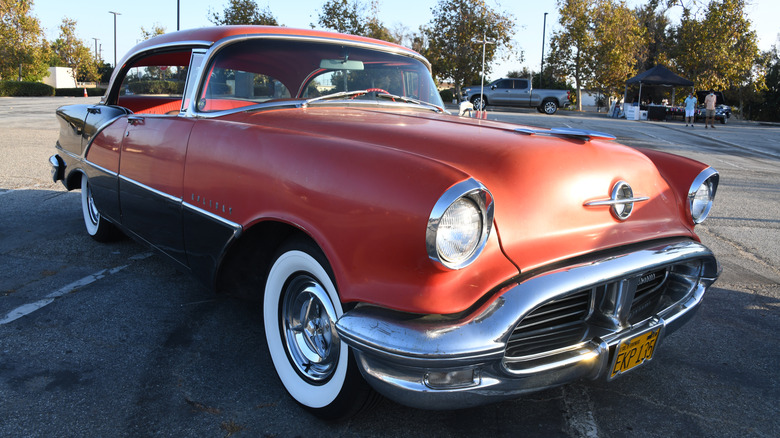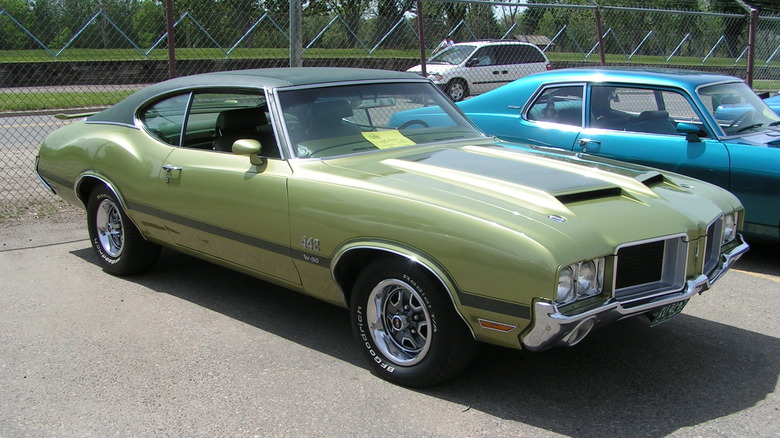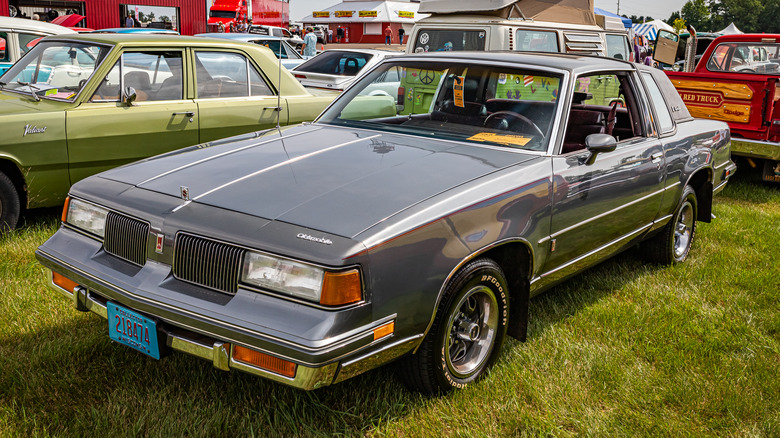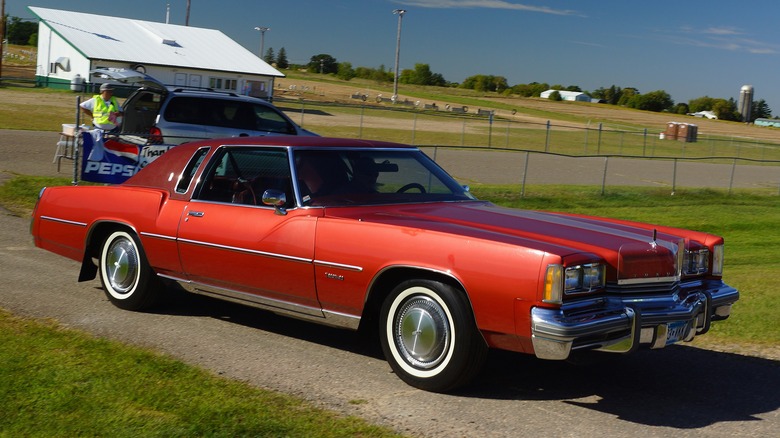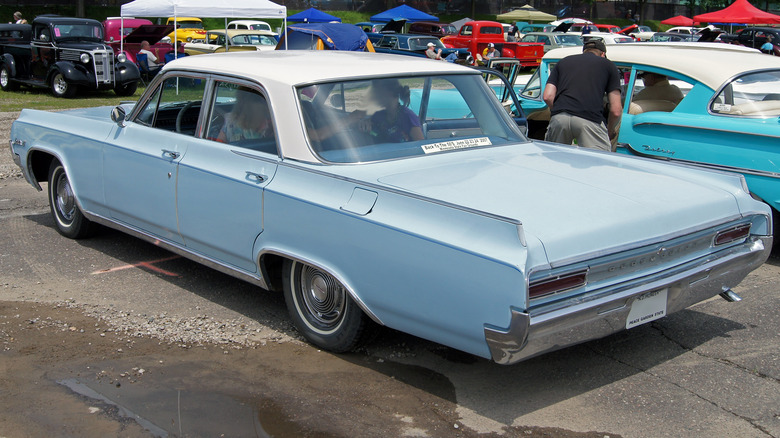5 Cheap Vintage Oldsmobiles To Consider For Your Next Restomod Project
Rehabilitating an old car is a great way to develop your wrenching skills and bring back a neglected piece of automotive history. You could opt for a traditional restoration project, where the goal is to get the car back to its original condition using as many factory parts as possible. A more creative — and often more affordable — endeavor is a restomod, where you are free to use fabricated parts and upgraded systems like fuel injection and electric drive.
Performing a restomod will disqualify you from entering your finished product in many car shows, but cars are meant to be driven and enjoyed, not displayed for nit-picky purists in an attempt to win prizes. Oldsmobile had a long, proud history that spanned the entire 20th Century before GM's government bailout and subsequent restructuring led to the brand's demise in 2004, but Oldsmobile also brought us some memorable and underrated muscle cars during its heyday.
There might never have been a muscle car era without the Rocket 88, which dominated the NASCAR circuit for a few years after its 1949 release. In the early '60s, Olds built the F-85 Jetfire, one of the first turbocharged cars in history. Although those two models make fine candidates for restomods, their historical significance drives up demand and price. Looking deeper into Oldsmobile's catalog reveals a few models that can be picked up cheaply enough to leave you room in your budget for parts, paint, and gas to fill the tank of the finished product.
The 1954-56 88
In 1954, Oldsmobile ignored the old adage "Don't mess with success" and updated the 88. The model had been a huge hit with race drivers and moonshine runners and inspired what is regarded as the first rock 'n roll song ever recorded, "Rocket 88" by Jackie Brenston and the Delta Cats. The second-generation 88 got a redesigned lower body and new glass along with a larger 324-cu-in V8. With the standard 2-barrel carburetor, that engine produced 170 hp, according to the Crittenden Automotive Library. Opting for the top-of-the-line Super 88 trim gave buyers a 4-barrel carb that boosted output to 185 hp.
The second generation of the 88 lasted through 1956, during which Oldsmobile produced more than 1.2 million units, according to Automobile Catalog. Only about 25,000 of those were convertibles, though, so finding a ragtop 88 will be a challenge. Hardtops are still plentiful and usually sell for between $10,000 and $20,000, although bargains can be found for under $5,000 on occasion. The high production numbers mean salvage yards are fertile ground for parts, and installing a fuel injection system or high energy ignition distributor will make a vintage Olds V8 sing like a choir of angels.
The 1968-72 442
The 442 debuted in 1964 as an option package on the F-85 and Cutlass, taking its name from the 4-barrel carburetor, 4-speed transmission, and dual exhausts. In 1968, the 442 was split off into its own nameplate, and a special Hurst/Olds edition with a monstrous 455-cu-in V8 was released. The 442 reverted to its status as an option package on the Cutlass S in 1972, and the demotion — combined with a change in how horsepower numbers were reported — put a major dent in demand for the 442.
In 1971 and 1972 combined, Oldsmobile made a little more than 17,000 442s (via Muscle Car Club), which was about half the number produced in 1968 alone. You'll have a hard time hunting down one of the 515 Hurst/Olds 442s made in 1968, but some of the approximately 90,000 second-generation 442 specimens that have survived the intervening five-plus decades can be found in the $10,000-$20,000 range if you exercise some diligence. Upgrades for GM engines of the era are easy to come by, and the right modifications can turn an ordinary 442 into a profitable venture. One owner rebuilt a 1970 convertible with a Ford positraction rear axle, MSD high-energy ignition system, and custom-built suspension and frame and sold it at auction in 2022 for $99,000.
[Featured image by dave_7 via Wikimedia Commons|Cropped and scaled|CC-BY 2.0]
The 1978-88 Cutlass Supreme
Oldsmobile first used the Cutlass nameplate on a 1954 concept car, taking the name from the Navy's Chance-Vought Cutlass fighter plane. The Cutlass went on sale in April of 1961 as a high-end version of the F-85, and became a standalone model in 1966. That was the same year the luxurious Supreme submodel debuted, and the next year Oldsmobile offered the 442 version of the Cutlass for the first time. The mid-'70s Cutlass was a sales juggernaut, accounting for 43% of the division's sales in 1974 (via the Critttenden Automotive Library). The entire Cutlass line was reduced in size in 1978, and the Supreme's appeal was slightly dented by the Cutlass Calais, which replaced the unpopular Salon version.
All Cutlass models moved to a front-wheel drive platform in 1988, which it shared with the Pontiac Grand Prix, Buick Regal, and Chevrolet Lumina. According to Automobile Catalog, Oldsmobile made about 3.75 million Cutlasses between 1978 and 1988, all but about a million of which wore the Supreme label. Those staggering production numbers make the Cutlass Supreme an easily accessible classic today, with a sizable portion of the remaining stock going for less than $10,000. Many of them have already been modified for racing, which means a good portion of your restomod efforts may be weighted towards the "resto" half of the equation.
The 1971-78 Toronado
The Toronado first appeared in 1966, bringing front-wheel drive back to the American car market for the first time since the 1937 Cord. Motor Trend gave it Car of the Year Award honors, noting that "never in the 14-year history of this award has the choice been so obvious and unanimous. The Toronado is symbolic of a resurgence of imaginative engineering and tasteful styling in the U.S. auto industry." In 1971, a redesign included a move from a subframe construction to the more traditional body-on-frame style, as well as an upgrade from rear leaf springs to coils. Minor design changes were made over the next half-dozen years, and the Toronado was downsized significantly for the 1979 model year, when production moved from Lansing, Michigan, to Linden, New Jersey.
The Toronado's roomy interior and robust features make it a good base for a modern restomod, and the V8 engines used throughout the second-generation run are easy to upgrade with modern fuel injection and ignition systems, as well as custom exhaust headers that can boost horsepower beyond the already-impressive stock numbers. Good condition Toronados are a huge bargain on the used market, routinely selling for under $10,000 in the past few years.
[Featured image by Greg Gjerdingen via Wikimedia Commons|Cropped and scaled|CC-By 2.0]
The 1964 Jetstar 88
Oldsmobile introduced two Jetstar models in 1964: The full-sized Jetstar 88 (pictured above) and the slightly smaller Jetstar I. Both Jetstars had bucket seats with a console between them and came with a 394-cu-in, 345 hp V8 (via Mac's Motor City Garage). The Jetstar I was about $500 cheaper than its larger brother, thanks largely to the lack of standard amenities like an automatic transmission and power steering and brakes.
The 1964 Jetstar didn't enjoy the huge production run as the 88 or Cutlass, with only about 16,000 Jetstar Is made that year and about 60,000 Jetstar 88s making their way through the assembly line. Both Jetstars were updated for the 1965 model year, although production dipped sharply for both versions. The small production runs mean they're relatively hard to find today, but several 1964 Jetstar 88s have sold for under $20,000 in recent years. As with other V8-powered Oldsmobiles, there is a wide selection of fuel and ignition system upgrades for the engines used in Jetstar models.
[Featured image by Greg Gjerdingen via Wikimedia Commons|Cropped and scaled|CC-By 2.0]
